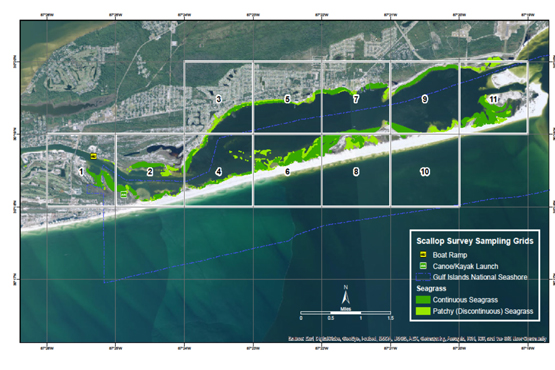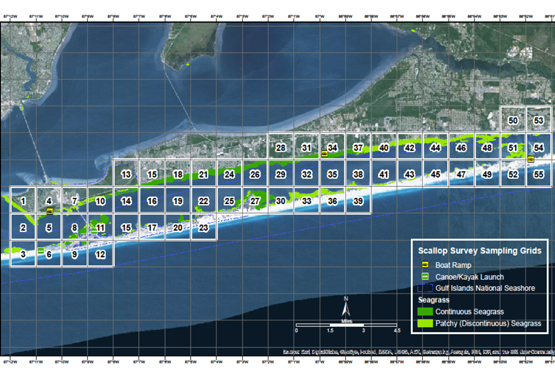Introduction
The bay scallop (Argopecten irradians) was once a common bivalve in the lower portion of Pensacola Bay. Found in the thick grassbeds of Big Lagoon and Santa Rosa Sound, it provided both a recreational and commercial fishery until both were closed due to the drastic decline of the animal beginning in the 1960s. The cause of this decline could be a variety of things but most likely involved reduction of water quality, reduction of suitable seagrass habitat, and overharvesting. The animal was once found from Pensacola to Florida Bay north of the Florida Keys but is more or less restricted to the Big Bend area of our state at this time. Commercial harvesting is banned along the Gulf coast of the state and recreational harvest is only allowed during certain seasons in the Big Bend. There are bag limits.

Project Objective:
The objective of the Great Scallop Search Project is to determine presence/absence/abundance of bay scallops in Florida Gulf Coast counties where the animal was once common but is now rare and closed to any harvesting. The project was developed by Florida Sea Grant in Charlotte County and was initiated in the Pensacola Bay area in 2015.
Project Methods:
Volunteers are trained to snorkel along a 50-meter transect line anchored to the bottom in one of several 1×1 nautical mile grids laid out in either Big Lagoon or Santa Rosa Sound. There are 11 such grids in Big Lagoon and 55 in Santa Rosa Sound.
Fig. 1 Big Lagoon
Fig. 2 Santa Rosa Sound
On survey day, each trained volunteer visits their assigned grid to conduct four 50-meter transects. The transects are anchored to the bottom over suitable scallop habitat (seagrass) and two snorkelers, one on each side, swims along searching for live scallops. Dives are made in six feet of water or less and take about two hours to complete a grid.
While there, they also report the status of the seagrass, sediment type, and for the presence/absence of macroalgae. Any other notes of interest are logged.
All surveys occur during the last week of July.
2022 Project Results
21 teams surveyed the area in 2022. 8 surveyed Big Lagoon and 13 surveyed Santa Rosa Sound.
There was a total of 74 volunteers on these 21 teams. 36 on the 8 teams from Big Lagoon, 38 on the 13 teams from Santa Rosa Sound.
27 total surveys were conducted over a 54-hour period. Adjusting for the number of volunteers this was a total of 148 hours of volunteer service. THANK YOU!
These 27 surveys covered 22 of the total 66 grids (33%). 5 of the 11 grids (45%) in Big Lagoon were surveyed. 17 of the 55 (31%) in Santa Rosa Sound were surveyed.
87 total transects were surveyed which covered 8540 m2 (2.1 acres) in both bodies of water. 38 transects were surveyed in Big Lagoon (3640 m2, 0.7 acres), and 49 in Santa Rosa Sound (4900 m2, 1.2 acres).
The seagrass species found were shoal grass (Halodule wrightii) and turtle grass (Thalassia testudinum). The density of the blades within a transect ranged from 5 to 100% coverage. 17 of the 27 surveys (63%) reported seagrass densities at 100% coverage. Note: remember volunteers selected their sites within the grid and would have selected high grass density locations due to the fact scallops prefer it.
Volunteers were also asked to report on occurrence of macroalgae at their sites. The presence/absence in Big Lagoon was 50/50, but in it was either “yes – present” or “abundant” in Santa Rosa Sound.
2 live scallops were found. Both by the same team surveying grid #27 in Santa Rosa Sound.
These scallops were found in 3-7 feet of water, in a grid that was 50-100% covered by seagrass, both species of seagrass were present, macroalgae was present, and the bottom was sand. The height of the two scallops were 30 and 33 mm, small for bay scallop.
Scallop shells were found in grid #11 in Big Lagoon.
Two lionfish were reported (but not confirmed) from grid #11 in Santa Rosa Sound.
Discussion
Since 2015 we have only had 3 live scallops reported. The populations in Pensacola Bay are all but gone. However, we did find 3 and there have been confirmed and unconfirmed reports of live animals seen outside of our surveys and cleaned shells at boat ramps. This suggest that a small population may be trying to hang on here.
There has been discussion with trying to re-introduce scallops to this bay using the Scallop Sitters Program currently being used in Bay, Gulf, and Franklin counties to our east. However, the scallops used in the current project come from those locations. We do not have such number here. Also, there is still a question of water quality. Though the seagrass reports from this project suggest improvement, no water quality is being monitored. We are currently monitoring salinity in another project. These scallops will need salinities at, or above, 20 ppt. to be successful.
We will continue to conduct the Great Scallop Search each July. If you have any questions concerning this project, please direct them to Rick O’Connor at roc1@ufl.edu.
 6
6


